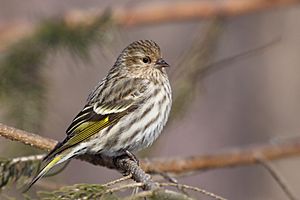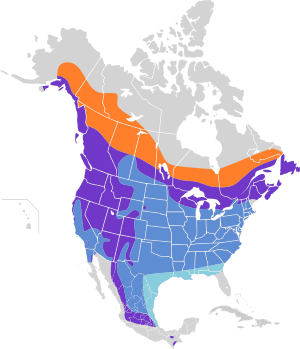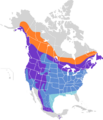Pine siskin facts for kids
Quick facts for kids Pine siskin |
|
|---|---|
 |
|
| Conservation status | |
| Scientific classification | |
 |
|
| Geographical distribution of Pine siskin. A small portion in western Guatemala is not shown. Breeding Year-round Nonbreeding Nonbreeding (scarce) | |
| Synonyms | |
|
Fringilla pinus |
The pine siskin (Spinus pinus) is a small bird found in North America. It belongs to the finch family. These birds are known for moving around a lot, especially in winter, depending on where they can find food.
Contents
About the Pine Siskin
Scientists give every living thing a special two-part name. This helps everyone know exactly which species they are talking about. The pine siskin was first officially described in 1810 by an American bird expert named Alexander Wilson. He gave it the name Fringilla pinus. The word pinus comes from Latin and means "pine-tree," which makes sense for a bird that loves pine trees!
Today, the pine siskin is placed in a group of birds called Spinus. This group was created in 1816 by a German scientist, Carl Ludwig Koch.
There are three main types of pine siskins, called subspecies:
- American pine siskin (S. p. pinus) – Found in Alaska, Canada, and parts of the U.S.
- Mexican pine siskin (S. p. macropterus) – Lives in northwestern and central Mexico.
- Chiapas pine siskin (S. p. perplexus) – Found in southern Mexico and Guatemala.
What Do Pine Siskins Look Like?
Pine siskins are small birds, about the same size as an American goldfinch. They are usually about 11 to 14 centimeters (4.3 to 5.5 inches) long. Their wings can spread out 18 to 22 centimeters (7.1 to 8.7 inches) wide. They weigh about 12 to 18 grams (0.4 to 0.6 ounces).
Adult pine siskins have brown feathers on their backs. Their undersides are pale with lots of dark streaks. They have short, forked tails. Their beaks are cone-shaped, like other finches, but they are longer and thinner. Many pine siskins have bright yellow patches on their wings and tails. Sometimes, they also have white streaks on their wings.
You can tell them apart from other birds by their streaky look, thin beak, and yellow or white spots on their wings.
Pine Siskin vs. Eurasian Siskin
The pine siskin usually looks quite plain. There's another similar bird called the Eurasian siskin, which lives in other parts of the world. Eurasian siskins are often much brighter, with green and yellow feathers. Male Eurasian siskins have a black cap and bright green and yellow bodies.
Pine siskins don't have these bright green and yellow colors. Their wing bars are usually buff-white, while Eurasian siskins have broad, yellow wing bars. Pine siskins also have a longer, straighter beak compared to the Eurasian siskin's shorter, curved beak.
Where Do Pine Siskins Live?
Pine siskins breed across most of Canada and Alaska. They also breed in the western mountains and northern parts of the United States. As their name suggests, they mostly live in open conifer forests, like pine forests. These northern forests are home to most of the pine siskin population.
However, you might also find them nesting in parks, cemeteries, or suburban woods. They can live in places with ornamental conifers or even leafy trees. While they love to eat seeds from cones in forests, they also look for food in many other places. These include deciduous forests, thickets, meadows, grasslands, and even backyard gardens. They often visit bird feeders that offer small seeds.
Their nests are usually well-hidden on a horizontal branch of a tree, often a conifer.
Migration
Pine siskins are known for their unpredictable movements. They are a "migratory" bird, meaning they travel between different areas. Their migration patterns change a lot, probably because they follow where food is most plentiful. In some years, many siskins will fly south. In other years, very few will move. This makes them one of the "irruptive winter finches," meaning their movements depend on how well the seed crops grow each year.
Pine Siskin Behavior and Life
What Do Pine Siskins Eat?

These birds search for food in trees, bushes, and weeds. They mostly eat seeds and parts of plants. They also eat some insects. In winter, they often join flocks with other birds like American goldfinches and redpolls.
Their favorite foods are small seeds, especially from thistle, red alder, birch, and spruce trees. Pine siskins can store a lot of seeds in a special pouch in their throat called a crop. They can store up to 10% of their body weight in seeds overnight! This gives them extra food for cold days.
They also eat young buds from willows, elms, and maples. They will munch on soft stems and leaves from weeds and even young garden vegetables. They also pick seeds from grass, dandelions, chickweed, sunflowers, and ragweed. If you have a bird feeder, pine siskins might visit to eat seed pieces left by bigger birds.
In summer, they eat many insects, especially aphids, and some spiders. They feed these protein-rich insects to their young to help them grow. By winter, even young siskins mostly eat seeds.
Surviving the Cold
Pine siskins are amazing at surviving in very cold weather. Their bodies naturally burn energy about 40% faster than other songbirds their size. When temperatures drop to extreme lows, like -70 degrees Celsius (-94 degrees Fahrenheit), they can speed up this process even more, up to five times faster for several hours! They also store more winter fat than their relatives, like the common redpoll and American goldfinch.
They also protect their young from the cold. Their nests are often very well insulated with thick plant materials. The female bird might stay on the eggs and hatchlings almost constantly, keeping them warm, while the male brings her food.
Conservation Status
Even though the pine siskin is common in some areas, like Washington state, its population has been declining since 1966. Because these birds move around so much, it can be hard to track their exact numbers.
Sometimes, other birds like brown-headed cowbirds lay their eggs in siskin nests. This can harm the pine siskin population because the cowbird chicks might outcompete the siskin chicks for food. Cutting down large areas of forest can also make it easier for cowbirds to find siskin nests. Protecting large areas of conifer forest is important to help keep this bird common.
Images for kids
-
Pine siskins feeding on thistle seeds
See also
 In Spanish: Jilguero de los pinos para niños
In Spanish: Jilguero de los pinos para niños





